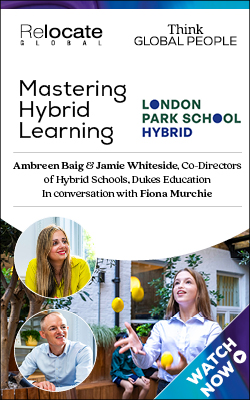Emerging trends in international schools
International schools met to discuss non-AI global and regional trends at Pearson’s International School Leaders Conference and how they are working to best prepare students for the future.

The latest issue of Think Global People magazine is out now!
With more and more companies operating across different locations, international schools are seeing significant growth. To help illustrate this, Rachel Rogers, Head of Sales, shared some figures from ISC Research over the last five years.“The number of global international schools has grown from 13,190 to 14,457 – a 10% growth, with the number of students now at 7.3 million, up from 6.4 million, and the total fee income of international schools sitting at $64 billion.”While global teacher shortages remain a challenge, Rogers shared that teaching staff have increased from 603,083 to 693,629 and shared some positive stats on teacher satisfaction.“Despite the many challenges during Covid-19, including expatriate repatriation, salary challenges for many families, and restricted access to school facilities, the international schools market has maintained its enrollments and in some cases gained, as a result of transitioning students from local, public and private schools to better quality online learning.”The past few years have seen several emerging trends, said Rogers, with some of the largest trends including hybrid and online schooling to student wellbeing and learner agency.“The majority of international schools, around 78%, now offer a hybrid curriculum. This often combines various strands from local and international curricula, such as programmes from International Baccalaureate as well as programmes from the UK and US, plus elements from the national curriculum in which the school is located, following a more international ethos.”While hybrid curricula models offer more varied learning programmes, they also offer invaluable flexibility for globally mobile parents, including both in-person teaching and online schooling to broaden access.Rogers further highlighted a growing trend among schools focusing on learner agency, to prepare students for higher education and work, such as “learning to make responsible decisions for themselves and others and learning to act rather than be acted upon.”Rogers discussed how many international schools are redirecting and enhancing their focus on core topics that are important to their students. These topics include environment and sustainability, mental health, gender equality, discrimination and equal access to education.Chairing a mixed panel of international school leaders, Rogers showcased some of the ways schools are adapting and responding to these trends.
Read related articles
- New transatlantic partnership aims to put children’s voices at the heart of AI development to address impact and risks
- Supporting international students’ wellbeing at university
- Lessons in Wellbeing
Panellists:
Kamran Baig, Founding Director, Lucerne International School, SwitzerlandSeema Irfan, Principal of City School (Southern Regional Office), PakistanRob Jamieson, Head of International Partnerships at PearsonStephen Priest, Principal of Repton School CairoOn student wellbeing and agency
Seema Irfan: There is a growing shift in many schools towards valuing well-rounded success over academic achievement alone. Schools are recognising that academic success without personal wellbeing is unsustainable, leading to a more comprehensive approach that nurtures a students intellectual, emotional and social development.We know that when wellbeing is prioritised students are more engaged, motivated and resilient which enhances their academic performance and social development.There are various factors that can lead to high levels of stress and anxiety for students. These include high performance expectations, fear and social pressures to uncertainty and changes for personal and external reasons, so wellbeing is built into City School’s vision and strategic planning, making student wellbeing a shared responsibility.Our child protection policy also includes health and wellbeing programmes. All our schools have designated safeguarding leads and deputy leads that are trained to understand various forms of abuse, the signs and potential impact on students to facilitate a pro-active safeguarding culture within each school and foster a safe and healthy environment for students.Each school year, we have two in-service training days as part of our school calendar. A couple of years back, we went strong on wellbeing and aligned all our overarching training themes. These themes included mindfulness, inclusivity and celebrating diversity. We then focused on embedding learning experiences and activities across all our subjects that were specifically designed to develop emotional intelligence, empathy, self-regulation and teamwork to help students feel empowered to lead, manage stress and communicate effectively.Our school leaders are trained to counsel students to ensure their voices are heard and to help them integrate and participate. We know that wellbeing is nurtured when classrooms are safe and supportive. Our teachers are trained to promote respect, kindness and empathy using positive reinforcement to manage a space where students feel comfortable in expressing themselves.Wellllbeing is most effective when it extends beyond the school, too. We now host seminars and workshops where families are invited to participate in helping to create a cohesive support system for their children.Stephen Priest: We have to raise awareness of what wellbeing is and ensure that our students are aware about managing their own wellbeing. I look at it more in terms of the root of what we're teaching. Some call these soft skills or 21st century skills but we're now a quarter of the way through the 21st century and I'm not sure whether we have really put social and emotional learning at the forefront.Schools and educational organisations are still a little bit stuck in a subject-based paradigm but we all agree that things have to change and be done differently. Bringing forward social and emotional learning and developing those related skills in our students should be at the heart of what we do.The reality is students are not going to be successful at examinations, at school, at university, or in their careers, unless they develop all the social and emotional skills necessary to manage their wellbeing and be a part of society.Across all our Repton schools around the world, one of our aims and values is wholeness. We develop that wholeness among our students by looking outside the knowledge that forms traditional education and look at the holistic development that children need. This approach allows students to develop their skills in resilience, collaboration and communication, so they know how to talk to different audiences and empathise with other viewpoints.Kamran Baig: Students are becoming very clear about what is important to them and mental health and protecting their wellbeing is up there, so it’s important for us to embrace that.Student agency is another fundamental area for us. In our personalised learning programme, we really encourage everyone to come as their authentic selves. It’s important that students know how to verbalise how they're feeling and are able to self-reflect.Our approach has been about schooling around the student, not forcing the student to fit into a box to fulfil the curriculum, or what a school needs, which can cause real damage to children and young adolescents.I really believe that if we get it right at school, we will see a generation of well-balanced and healthy people that can have a positive impact on the world.On hybrid learning
Rob Jamieson: We work with a range of online and physical schools to deliver content in a hybrid fashion and hybrid learning has really found its time, because it works. In controlled case studies, we’ve seen that the results of students learning in a hybrid way are better than those that are frequently in full-time physical schools and that’s because hybrid is good for everyone.It’s good for students because when it's done well, it involves a more personalised approach and allows teachers to take a different role that’s more of an individual coach or mentor. It also allows the balance between synchronous and asynchronous learning to change so that students can work more individually on their specific strengths and weaknesses, with the teacher intervening to improve their performance when needed.Hybrid learning promotes independence, too. We’ve had feedback from parents who have children working fully online or in a hybrid context, stating that their child was better prepared for their progression into higher education as a result of that element of independent learning.From a wellbeing perspective, we’ve also seen some fantastic results. Being able to work from home in a safe environment has had enormous benefits, in particular for students with SEND profiles. We’ve seen huge progress in accessibility, and attendance of former school refusers, as well as students who have been previously excluded from school, or whose special needs have made a physical school a difficult environment to learn in.Kamran Baig: Hybrid learning has proved to be a much better use of time for our students. In a hybrid or blended learning environment, our students spend much more time engaged in learning. We’ve had positive feedback that our students go on to do better at university due to the skills embedded in their hybrid programme that helps set them up for the future.

Find out more about the Think Global People and Think Women community and events.

Subscribe to Relocate Extra, our monthly newsletter, to get all the latest international assignments and global mobility news.Relocate’s new Global Mobility Toolkit provides free information, practical advice and support for HR, global mobility managers and global teams operating overseas.
©2025 Re:locate magazine, published by Profile Locations, Spray Hill, Hastings Road, Lamberhurst, Kent TN3 8JB. All rights reserved. This publication (or any part thereof) may not be reproduced in any form without the prior written permission of Profile Locations. Profile Locations accepts no liability for the accuracy of the contents or any opinions expressed herein.




































